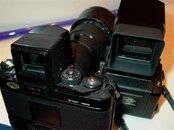f3nikon
Guest
I know the aftermarket housing peddlers do not what to hear this...I am a big fan of DSLRs, in fact I was the one pushing for the 60mm macro over the 105mm from my past post, I am just not convinced on its wide use in U/W photography.
"Can I see all the edges at one time? Sometimes, but it really doesn't matter. I can shoot 4 frames in the time I could shoot one with a P&S, because I have a frame buffer."
Are you saying that with 4 frames at a time you are "shot gunning" your photography and bracket the composition? Define that "sometimes" when do you see the entire frame? And how fast can your strobe recycle?
I have seen images from folks using a DSLR but started with a PS...some of the composition actually got worst on the DSLR! The image quality did improve with the DSLR but the earlier PS they were using had half the amount of megapixels and to top it off they slapped an add-on close up lens to degrade the image even more.
Now compare that with the Nikon 5100 that you mention or the Canon G series at 12 megapixels...now its a different ball game in U/W photography. Notice I did not say fashion or wedding or any other land base photography.
I had always wondered why the top DSLR and PS makers like Canon or Nikon really did not bother to make housings for their DSLRs?
"Can I see all the edges at one time? Sometimes, but it really doesn't matter. I can shoot 4 frames in the time I could shoot one with a P&S, because I have a frame buffer."
Are you saying that with 4 frames at a time you are "shot gunning" your photography and bracket the composition? Define that "sometimes" when do you see the entire frame? And how fast can your strobe recycle?
I have seen images from folks using a DSLR but started with a PS...some of the composition actually got worst on the DSLR! The image quality did improve with the DSLR but the earlier PS they were using had half the amount of megapixels and to top it off they slapped an add-on close up lens to degrade the image even more.
Now compare that with the Nikon 5100 that you mention or the Canon G series at 12 megapixels...now its a different ball game in U/W photography. Notice I did not say fashion or wedding or any other land base photography.
I had always wondered why the top DSLR and PS makers like Canon or Nikon really did not bother to make housings for their DSLRs?





